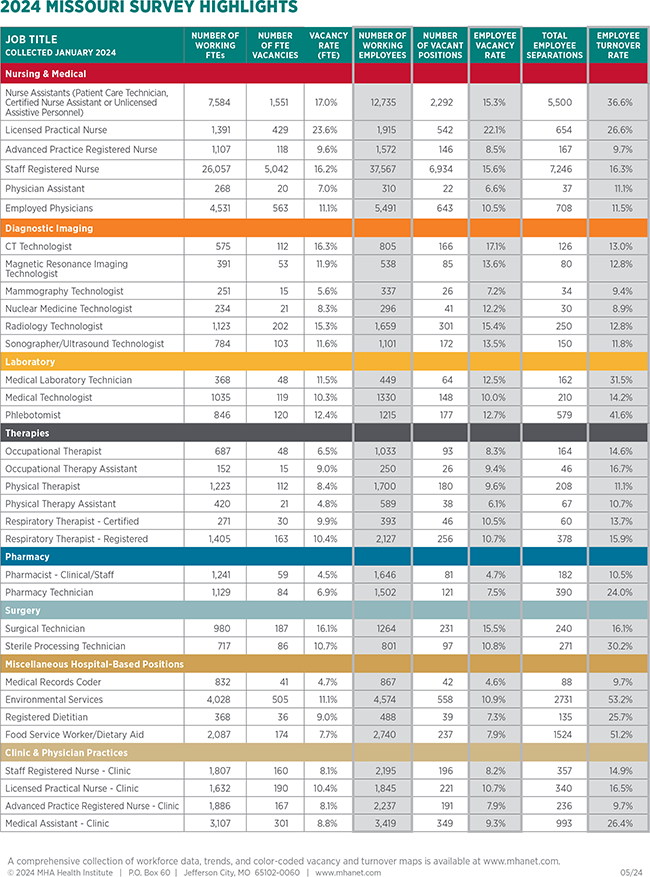Expert

Jill Williams
Actions
Type
Topic
- Economic Impact
- Workforce
Tags
Data on the Missouri hospital workforce from 2023 finds a continued easing of the record-high vacancy and turnover rates experienced during the pandemic. Although this limited relief is good news for hospitals and the communities they serve, 2023 rates remain higher than prepandemic, historical rates. Real challenges remain — among today’s workforce and in building the workforce of the future.
Hospital leaders increasingly cite the stability of the workforce as a top concern. The aging of skilled workers, and the challenges of a highly dynamic and sometimes stressful work environment, contribute to the difficulties. Constraints on the pipeline for new workers, and the cultural shifts to new models of work and care, add to these difficulties.
While the immediate operational challenges of staffing are of concern, additionally important are longer-term considerations. Expected increases in demand for care, resulting from an aging population and comparatively poor health in Missouri, will require ongoing attention to the supply-demand gap for caregivers and support workers. Continued investments will be necessary to ensure hospitals have the workforce needed for the future.
This year’s report focuses primarily on the status of the workforce. However, new and existing programs in support of workforce development — through MHA, the hospital community and partners, and the state of Missouri — are generating opportunity to stabilize and grow the workforce. Additional information about these programs and partnerships is available.
All Missourians have a stake in the strength of the hospital workforce. Continued investment and dynamic thinking about how to deliver the hospital and health care workforce that Missourians need and deserve will be essential to hospitals’ ability to deliver care.
2024 Statewide Report
A printable Workforce Report also is available.
The report includes statewide and regional data from 128 hospitals and includes vacancy and turnover rates for 33 hospital- and clinic-based positions.
2024 Regional Reports
Hospitals must have an adequate workforce to ensure access to high-quality care, all day, every day. MHA’s workforce data collection focuses primarily on the influence of two components — vacancies and turnover. The inability to find staff to fill open positions at a hospital or clinic creates vacancies. When a staff member leaves and is replaced, this results in turnover. Both challenges can influence hospital operations and organizational culture.
Staff registered nurses are the largest cohort of employees at Missouri’s hospitals and are essential to care delivery. Statewide, the staff R.N. vacancy rate was 15.6%, while the turnover rate was 16.3% — a 1.8% and 3.1% decrease, respectively between 2022 and 2023.
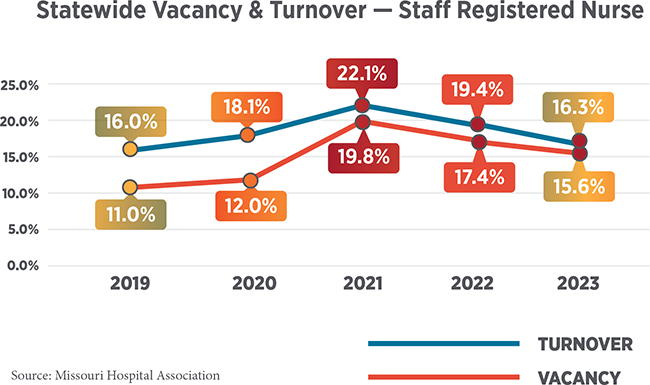
Although smaller in number in the workforce, nurse assistants and licensed practical nurses provide essential support in bedside care. Statewide, R.N.s, LPNs and nurse assistants — which include patient care technicians, certified nurse assistants and unlicensed assistive personnel — all rank in the top 10 for vacancy, while LPNs and nurse assistants also are included in the top 10 for turnover.
Hospitals face challenges throughout the workforce. Outside of the care delivery and clinical support professions, thousands of workers support hospital operations. With staff R.N. workers as an outlier, there is a strong correlation between education and licensure requirements. Most of the higher vacancy and turnover positions included in this survey occur in positions that require lower educational attainment or lack licensure.
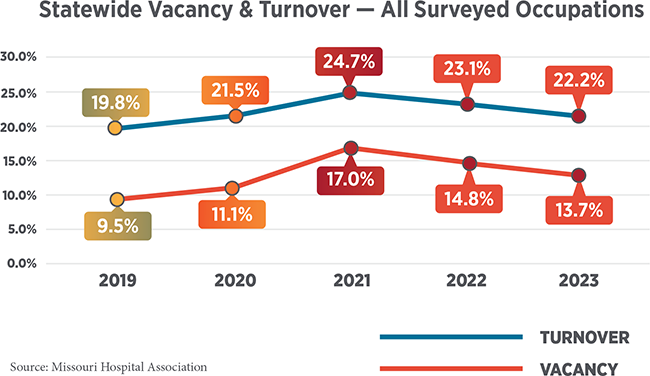
Every surveyed position contributes to hospitals’ ability to provide high-quality care and improve patient outcomes and experience. Although many of the high vacancy and turnover positions are not visible at the bedside, they are essential to hospital operations. Two examples included in the data are environmental services and food service-related workers. Although the vacancy rates for these positions are not remarkably high as they require little formal training, the statewide turnover rate exceeded 50% — a 10% increase over 2022. This high level of turnover is disruptive and costly for hospitals.
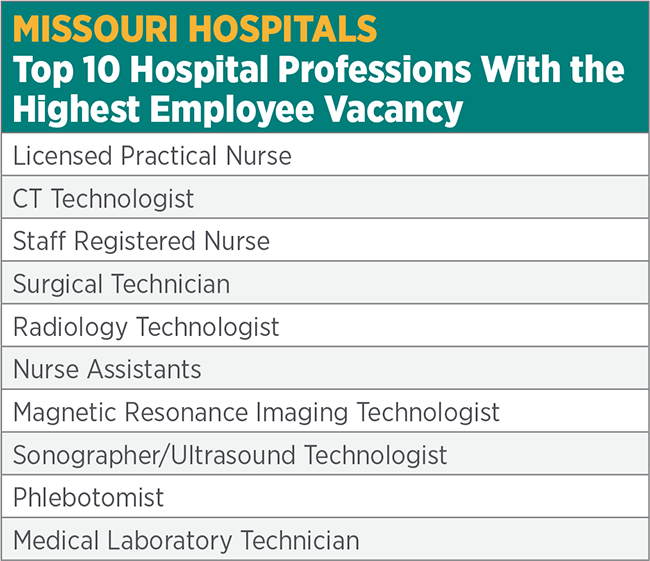 |
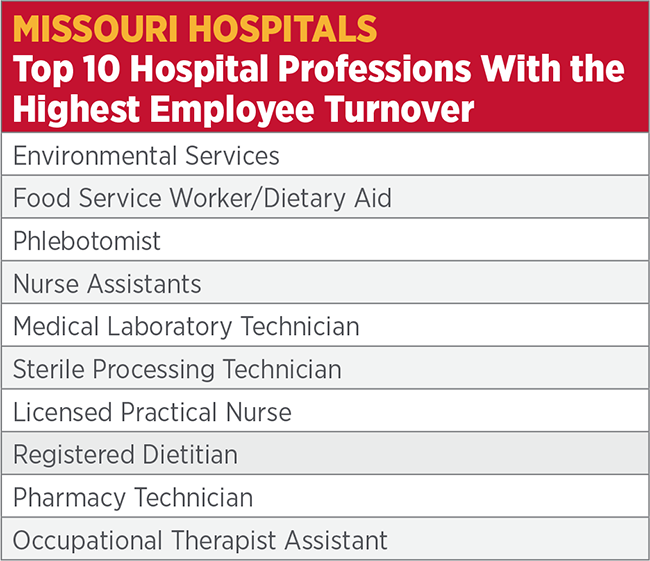 |
Many of the fastest-growing health care roles will require minimal formal training and education. The careers included in the tables are listed in order of highest to lowest percent.
Although many health care workers have education, certification and licensure that allow them to move between settings and institutions across the state, a large part of the workforce are, and remain, local. Ensuring hospitals have access to a pool of skilled health care workers — nurses, therapists, imaging specialists and lab workers — is essential to care delivery. Geography can play a role in the pool of available workers.
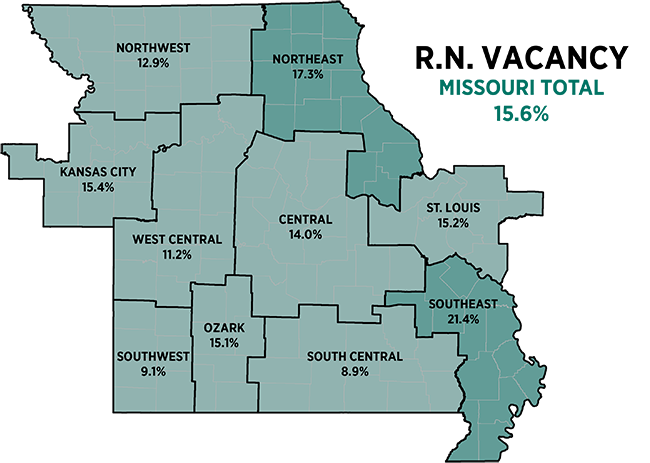 |
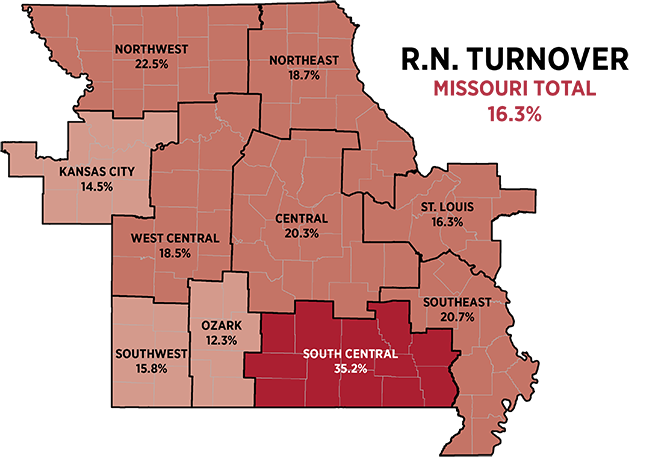 |
Regional variation is evident in staff R.N. data, where turnover among staff is especially pronounced in rural parts of the state. In the South Central region, the turnover rate of R.N.s is twice the state average at 35.2%. In this same region, the R.N. vacancy rate is the lowest statewide at 8.9% against a statewide average of 15.6%. Although the number of staff R.N.s is small, 631 of 37,567 statewide, the significant turnover rate can influence a hospital’s culture — within the nursing staff and throughout the organization.
In the St. Louis region, hospitals experienced a turnover rate of approximately 75% in environmental services and food service workers/dietary aids. Vacancy rates in both categories are low, which implies that filling these positions when there are separations is possible. Many hospitals indicate finding qualified entry-level staff is difficult due to competitive pay from different industries or larger companies, low unemployment, shallower job pools making qualified candidates harder to find, and a lack of training programs in rural areas. These careers are critical to patient care, and turnover in these positions presents an operational challenge for hospital leaders.
Data by region are available in the right-hand column of this page.
Every Missourian benefits from hospitals that thrive at managing operations, treating patients and serving their communities. Ensuring care is available in emergencies, and in the right setting with the right staff when Missourians need it, is essential to saving lives and maintaining health.
Continued investments that attract and retain workers to health professions, and that create opportunities for rewarding careers in service to the health of their communities, will be necessary to stabilize today’s workforce and build the workforce of the future. This will require coordinated efforts among education, policy, and health care stakeholders to ensure a robust, resilient, and well-supported hospital and health care workforce for all Missourians — now, and in the future.
